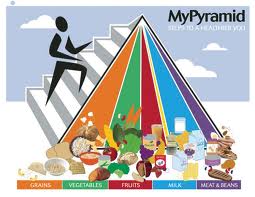 MyPyramid, the USDA’s most recent (2005) guide to a healthy lifestyle was a definite improvement to the previous USDA pyramid, responding to a great deal of research that had come out since the last USDA update in 1992. The new pyramid touts the benefits of whole grains as opposed to refined carbs, and shifts away from flour-based carbohydrates as the recommended base of the diet, to a more balanced approach inclusive of all food groups.
MyPyramid, the USDA’s most recent (2005) guide to a healthy lifestyle was a definite improvement to the previous USDA pyramid, responding to a great deal of research that had come out since the last USDA update in 1992. The new pyramid touts the benefits of whole grains as opposed to refined carbs, and shifts away from flour-based carbohydrates as the recommended base of the diet, to a more balanced approach inclusive of all food groups.
But while improvements were obviously made, the 2005 MyPyramid is still very questionable in it’s accuracy, contradicting some popular scientific findings.
Dairy is Necessary (??)
One of the most controversial aspects of the 2005 pyramid has been the abundance of Dairy in the recommended diet, and relatively weak and inconspicuous way that MyPyramid suggests limiting saturated fat intake. Represented by the blue color on MyPyramid, the USDA urges individuals to consume 3 cups of dairy every day. The picture associated with the ‘MILK’ section depicts a range of dairy including two large depictions of cheese, which is almost always high in saturated fat. Most nutrition experts seem to agree that dairy can be part of a healthy diet when saturated fat is largely excluded, but agree that dairy is by no means necessary, and is in fact largely absent from many examples of an ‘ideal’ diet, including the Mediterranean diet.
Meanwhile, more and more scientific evidence has emerged pointing to the benefits of vegetables and other plant-based foods. Many nutrition scientists recommend consuming vegetables “in abundance”, choosing not to put a limit on daily consumption. The USDA recommends only 2.5 cups, 1/2 cup less than dairy.
The only nutrition-based reasoning behind this push to consume dairy is based on the fact that humans between the ages of 19 and 50 need roughly 1000 mg of calcium daily (1). Three cups of dairy equals somewhere around 800 mg of calcium. What many people don’t know is that other foods are also calcium rich, enough so that you don’t have to consume dairy if you don’t want to.
1 cup of cooked collard greens – 266 mg calcium
1 orange – 76 mg calcium
1/2 cup of cooked spinach – 123 mg calcium
1/4 cup of almonds – 92 mg calcium (2)
Why does the USDA recommend 3 cups of dairy per day? Maybe because it is the easiest way to ensure that the average consumer get enough calcium in their diet? Maybe so that the U.S. dairy consumption, and therefore the U.S. dairy industry, which produces 95% of all dairy consumed in the U.S. (3), stays stable.
Though dairy seems to provide numerous health benefits, and is one of the easiest ways to get your recommended daily dose of calcium, the USDA is skewing nutritional science to say that humans need 3 cups of dairy per day, and only 2.5 cups of vegetables.
Make Half of Your Grains Whole (??)
MyPyramid also recommends 6 oz. of grains per day, and encourages at least 3 oz. to be whole grain. It is widely believed that refined carbs are not as good for us as whole grains. They are not only stripped of many of the most valuable parts of the grain which provide the bulk of the fiber, vitamins, minerals, antioxidants and phytochemicals, but they also spike blood sugar levels, leading to lethargy in the short term and type 2 diabetes in the long-term. Whole grains, on the other hand help, to stabilize blood-sugar levels, reduce bad cholesterol levels, which help prevent heart-disease, and have been shown to help prevent cancer.
Why only recommend half of grain consumption to be whole? It seems to be further proof that the USDA is making concessions to industry at the expense of our health.
The Harvard School of Public Health has issued its own ‘Healthy Eating Pyramid’ in response.
(1) http://www.disabled-world.com/artman/publish/calcium.shtml
(2) http://nutritiondata.self.com/
(3) http://aic.ucdavis.edu/research1/DairyEncyclopedia_policy.pdf
